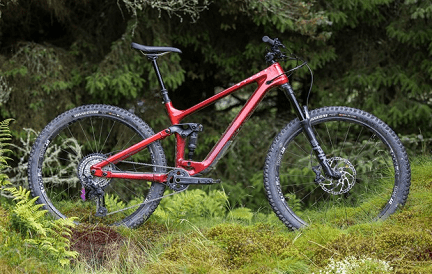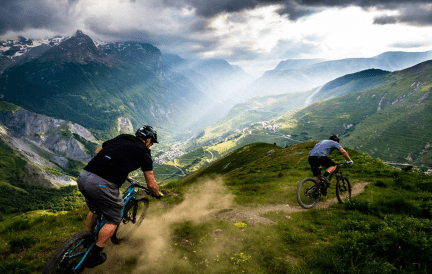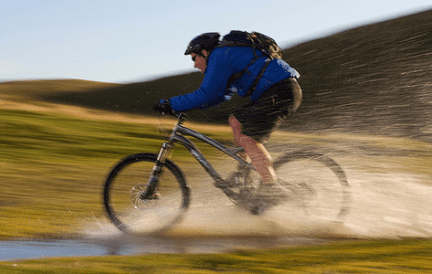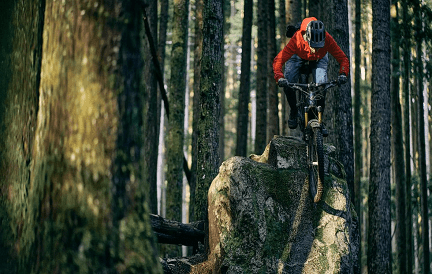Mountain riding has come a long way since the first mass-produced mountain bikes in the 1980s. Techniques such as downhill cycling and others have been around since then. Learn some of these aspects and more to help you find the best downhill mountain bike for you in this article.
- Part 1: What are Downhill Mountain Bikes
- Part 2: Types of Downhill Mountain Bikes
- Part 3: Basic Techniques for Mountain Biking
- Part 4: How To Dress For Mountain Biking
Part 1: What Are Downhill Mountain Bikes
Downhill Mountain bikes are tough, robust bikes designed for riding tight dirt paths. For operation, they feature broad, flat handlebars; for traction, they have two-inch or bigger tires with knobby tread; and for steep climbs and descents, they have wide-range drive trains and hydraulic disc brakes. Wheels are normally 27.5-inch or 29-inch in diameter; the earlier 26-inch is quickly becoming obsolete.
Women’s bikes have female-specific seats, smaller grips, narrower handlebars, and shorter crank arms. For smaller riders, most feature lighter suspension adjustment. Downhill mountain bikes nowadays are wonderful machines that are purpose-built for supreme confidence and enjoyment on a variety of trails.

This has been feasible because of new technology and designs, but it also complicates the process of selecting a downhill mountain bike. To get the most out of your money, learn the fundamentals of mountain bike construction, be honest about your riding style and skill, and know what types of trails you will be focusing the most of your time on.
Part 2: Types of Downhill Mountain Bikes
While manufacturers use a variety of labels to describe their bikes, there are four fundamental types: All-Mountain (Enduro), Trail, Cross Country (XC), and Downhill (DH).
Cross Country (XC) Mountain Bikes
Cross-country mountain bikes are designed for users that prioritize pedaling efficiency. These are lung-busting, uphill crushing machines bred for endurance and efficiency. Cross-country bikes have the most identical geometry to road bikes. Cross-country bikes, for example, sacrifice downhill performance in exchange for efficiency and weight. Cross-country mountain bikes are ideal for riders who want to pedal for lengthy periods and prefer climbing to descending. You can expect to pay nothing less than $900 on these bikes.
Features
- The largest mountain bike wheel size, 29″, is becoming popular on modern XC bikes. The rim diameter is the same as on a 700c road bike.
- The lightest mountain bikes you will ever see have ultra-lightweight construction (less than 24 lbs. in some cases) with a travel of 4.7″/120mm or less.
- In some situations, hardtails (front suspension alone) may be preferable in this category.
- Longer chainstays and wheelbases, as well as steeper head angles (69° or steeper) and longer stems, place climbers in a more efficient position.
- These bikes’ tires are likely to prioritize weight reduction, efficiency, and faster rolling resistance over grip, control, and durability.
Trail Mountain Bikes
Often when people think of “downhill mountain bike,” they think of this type. Trail bikes are mountain biking’s Swiss army knives, adept climbers as well as descenders. Trail bikes have greater suspension, gravity-oriented components (such as chunkier tires for improved traction and larger brake rotors), and a more relaxed geometry than XC bikes, making them more capable over a variety of terrain.
Do you envision yourself ripping about town and riding nearby trails all day long? Do you time your rides in seconds or grins and smiles? A trail bike is ideal if you enjoy mountain biking upwards as well as downhill and are searching for the occasional drop or jump. These bikes cost between $2,000 and $7,000.
Features
- The wheels on trail bikes are either 27.5″ or 29″. Suspension travel can range from 4.7″/120mm to 6″/150mm (front and back).
- Trail bike shapes are “neutral” head angles (66° or 68°) but can vary greatly to accommodate various riding patterns.
- Trail bike tires will find a mix between traction, durability, and rolling efficiency.
All Mountain or Enduro Mountain Bikes
This type may be described as the burly cousin of the trail bike. All-mountain bikes are the focus of the “Enduro” race format, in which climbing is required but only the downhill sections are timed and scored. If you want to earn your ride by pedaling uphill, but you are really in it for the downhill with technical terrain and airtime in mind, an Enduro mountain bike is the way to go.
An all-mountain bike, on the other hand, can handle a handful of loops at a bike park or even some shuttle-access terrain when you want to bypass the pedaling. These bikes cost between $3,000 and $25,000.
Features
- Enduro mountain bikes have 27.5″ or 29″ wheels, or a combination of the two with 29″ in the front and 27.5″ in the back.
- Suspension travel on all-mountain bikes is slightly longer than on trail bikes, ranging from 5.5″/140mm to 6.7″/180mm.
- Descending over rising is greatly favored by geometry. When it comes to steep climbs, head angles in the 65°-67° range might be tricky.
- When discussing current all-mountain/enduro geometry, crucial terms include long wheelbase and reach low bottom bracket, and slack head angle.
- Since the majority of the ride is gravity-assisted, all-mountain bike tires are inclined to favor aggressive knobs for cornering and traction.
Downhill and Freeride Mountain Bikes
Downhill bikes are built for speed, massive drops, and jumps on steep, rough terrain. With any of these bikes, you’re usually searching for an alternative to hiking, shuttles, or a chairlift to get to the summit of the trail. They are simply not designed to go anywhere but down. You will need at least $2,000 to buy these bikes.
Features
- Burly frames with 6.7″/170mm – 10″/250mm+ of rear suspension travel and 7″/180mm – 8″/200mm of front suspension travel with dual-crown forks that seem like they belong on a motorbike.
- These bikes have a very low center of gravity (bottom bracket) and a very slack head angle (less than 65°) for confidence on steep terrain and severe brown-pow roosting corners.
- Downhill bike tires are designed for grip and durability, having 2-ply (double-thick) casings.
Part 3: Basic Techniques in Mountain Biking
Mountain biking tactics differ from cruising about on tarmac in that they are used to navigate the tough terrain. While we encourage taking a class to learn some fundamental skills, we have detailed some essentials below:
Uphill Climbing
- Raise your throne: At the bottom of your pedal stroke, your leg should be nearly fully extended. This provides the maximum power while being the least taxing on your muscles.
- Keep Your Seat: On pavement, standing up might have worked in steep climbs, but on soft dirt, the lack of weight on the back tire typically results in rear-wheel slip. If you do not need the extra energy to help your back tire roll over an impediment, stay sitting.
Downhill Cycle
- Relax: Do not death-grip the handlebars, and try to keep your entire body calm. This will make the ride more comfortable and give you more control. You are more likely to make sudden moves that can send you off the bike if you are tight and stuttering.
- Drop your seat: On the way down, you won’t need the pedaling effectiveness of a high seat, so drop it and get it out of the way. Dropping your seat allows you to move around more freely.
- Stand up: Your legs and arms are of the best shock absorbers on the planet, even if your bike has suspension. Your (relaxed) body can help smooth out your ride by standing on the pedals and getting out of the saddle. To be ready for collisions and have control through uneven terrain, both your knees and elbows should be slightly bent.
Part 4: How to Dress For Mountain Biking
Although you may ride your downhill mountain bike in anything you like – some riders have even made a name for themselves while wearing denim on the world cup downhill circuit – but being equipped with the right gear will help keep you safe, relaxed, and happy. Dressing for mountain biking will always depend on factors such as where you ride, the weather, and the temperature. But there are some tips below to assist you to decide what to wear.
Chamois and Liner Shorts
The first step to ensuring that you’re comfortable when you hit the trails is to build a solid foundation. If you only buy one piece of mountain bike clothing, make it a good pair of chamois or liner shorts. Everything else is a “nice to have,” but these are a must-have. Chamois are padded shorts that will instantly improve your riding comfort. Downhill mountain bike chamois are available in both shorts and bibs; the choice is largely personal. In addition, some riders choose to brace by using products such as Chamois Butter. This anti-chaffing ointment can make long rides more comfortable.
Some cyclists prefer to ride without a cushioned chamois, especially on shorter trips, downhill, or when shuttling. If this describes you, non-cotton underwear with good wicking characteristics is a good choice. Merino wool is a popular choice for its comfort, sweat-wicking capabilities, and natural odor-fighting characteristics.
Mountain Biking Shorts and Pants
You will need some downhill mountain bike shorts or pants to wear over your chamois to keep you protected from the weather and collisions. Mountain bike shorts have a few advantages over other types of athletic and casual shorts. They have strategic stretch and cuts, increased toughness to withstand crashes, longer fitting to accommodate knee protection, and other features like vented panels or waterproof textiles.
Consider where you will be riding and what kind of rides you will be doing when selecting mountain bike shorts. This will help you find the right fit and features. If you ride in a hot region without knee pads, search for a lighter-weight short with a shorter inseam and improved ventilation. In the meantime, if you ride with knee pads, a longer inseam will assist you to close the gap between your pads.
Most downhill mountain bikers ride in shorts. But if you plan to ride in cooler weather, durable and padded mountain bike pants may be the best option. Mountain bike trousers have a slimmer cut at the ankles to avoid catching on your bike, but there is still enough room for knee pads underneath, and many offer sturdy protection for brutal downhill riding. Some mountain bike pants for cold weather riding have insulation as well.
Jerseys for mountain biking
When it comes to downhill mountain bike clothes, the top is definitely less crucial than the bottoms, but there are a few things to keep in mind. First and foremost, mountain riding is a great workout; you will sweat! Most mountain bike jerseys use wicking merino wool and synthetic fabrics to help you regulate your temperature. Second, accidents occur, and clothing offers protection. While a tank top will keep you cool while climbing, it will not protect you from the earth if you fall. For the best results, match your riding style to your wardrobe choices.
Helmets for Mountain Biking
The most vital piece of downhill mountain bike safety gear is your helmet, which goes without saying but we will say it anyway. Mountain bike helmets offer more protection over the back of your head and ears, as well as safety features like MIPS for enhanced impact protection.
Downhill Mountain Bike Gloves
Although not everyone like wearing gloves, we encourage them for all cyclists, particularly starters. Gloves not only improve your grip on the handlebars and brake levers, but they also minimize hand and arm fatigue, allowing you to ride for longer periods. Downhill mountain bike gloves also keep your digits toasty and protect you from falls. Look for gloves that fit your hand properly, with no additional material bunching in the way, so you can easily use your brake levers, shifter, and dropper post, and then match the warmth to your climate and riding location.









